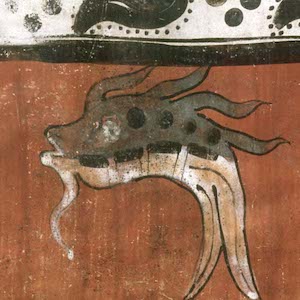Maya Vase Database: An Archive of Rollout Photographs
This website is a photographic database of painted and carved vases from the ancient Maya cultures of southern Mexico and Central America of the Classic Period (200-900 A.D.). The photographs, taken by Justin Kerr, a fine arts photographer, are critically important for understanding ancient Maya cultures for two reasons.
First, the vases offer the most detailed information available on Classic Period courtly life and mythology. These vases are unique among ancient Maya art forms in that they typically include full scenes from life and mythology, including multiple figures in action, accompanied by hieroglyphic inscriptions. Other common figural Maya art forms (statues, carvings on stucco walls) usually do not display the same complexity of scenes.
Second, Kerr took the photographs using a technique he perfected, called rollout (or peripheral) photography, in which the painting or carving that wraps around the vase is rolled out and reduced to a flat, two-dimensional photograph. As such, we can view the entire scene at once.
The database includes rollout images of more than 1,400 vases. Most are polychrome (multi-colored) painted vases, while others are carved stone vases and a few polychrome painted plates. The vases include scenes of palace life, mythology, warfare, and animals. Many of the vases are strikingly beautiful and thus make excellent illustrations for classroom use and for student analysis. The database is accompanied by more than 40 essays by scholars interpreting the iconography (common images and symbols). Justin Kerr and Barbara Kerr edited a series of six books analyzing the vases, as well. A subset of the photographs is zoomable, all the better for deciphering the accompanying hieroglyphs.
The database seems to have been created largely as a research resource for experts in Maya art and iconography. As such, contextual information about ancient Maya cultures is largely missing and the non-expert may find the site difficult to use. However, the website nonetheless can be a valuable resource for teachers, as well. For non-experts, searches by iconographic element and keyword (such as “deer” and “king”) are the most productive. A scroll-down list of 91 iconographic elements is provided, including ballgame, Maize God, Moon Goddess, Musicians, Ruler, Sacrifice, and Vision Serpent. Non-experts also will probably need to do some background reading in order to make best use of the site. A recommended text is Robert J. Sharer and Loa P. Traxler’s The Ancient Maya.
Each database record includes information on vase type, height, diameter, circumference, and the archaeological site at which the vase was found (the provenience), although sometimes the information is incomplete. The comments field provides a description of the scene for about half of the vases. The list of iconographic elements does not indicate where in the scene the elements.
